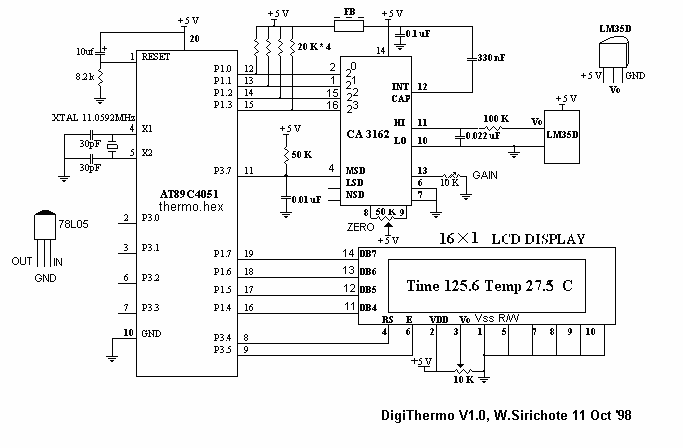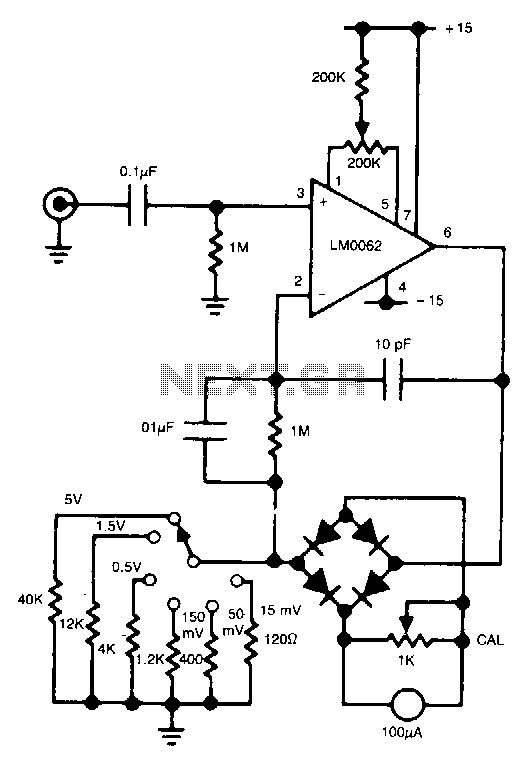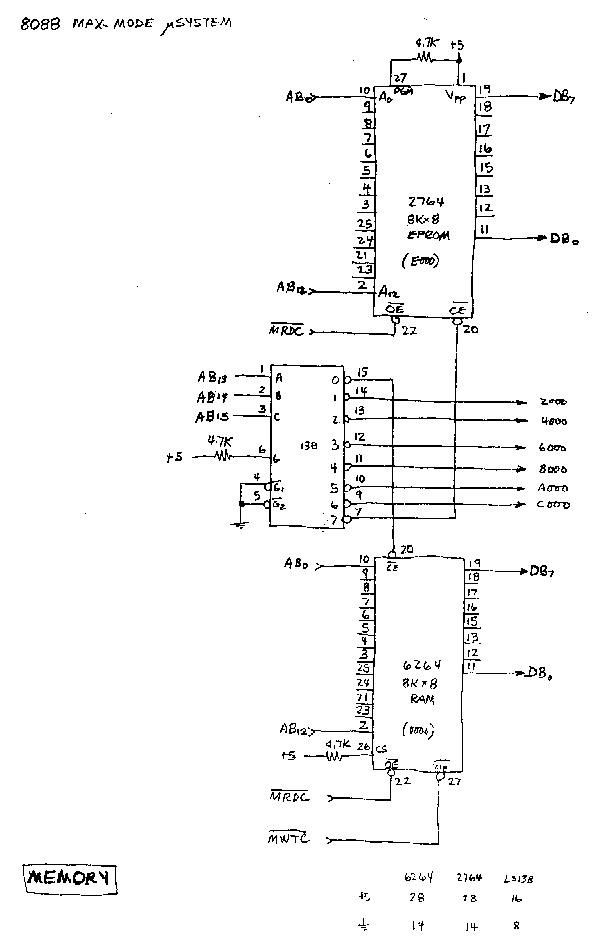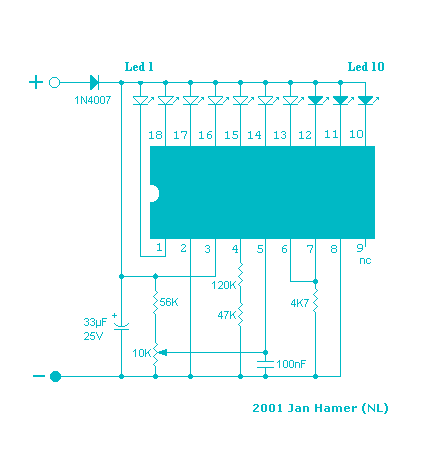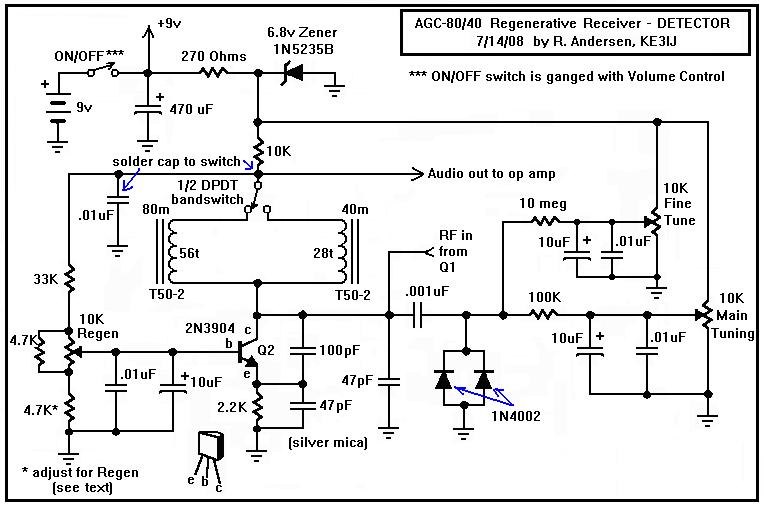
Single Meter Clocks

An alternating display for a version 1 nixie clock inspired new logic designs for switching signals to the display. The design eliminated the 4013 flip-flop and two 4017 counters, leading to a redesign of the hours section and reset circuits. A 4081 (quad 2-input AND gate) was utilized, with one gate functioning as a Set/Reset bistable. Another gate receives a signal when the hours reach 13, going HIGH to reset the hours, while the last two gates act as buffers, one connected to the 60Hz line. Modifications were made primarily to drive a single meter (a Heathkit "Antenna Impedance Meter" or a 0-100µA meter). The outputs of the 4017s were converted to analog signals through a homebrew DAC consisting of transistors and resistors. A 500K potentiometer was employed in series with a transistor; the pot was adjusted to one digit on the meter, and its resistance recorded, then retuned for the next digit, and so forth. A resistor ladder was constructed from the recorded resistances to transform digital signals into analog signals. For the meter to display 0, the resistance is open, resulting in no output. To display 1, the signal traverses the entire resistor ladder (approximately 520K total resistance), and subsequent values experience reduced resistance until the least resistance displays 9 (maximum). The clock circuits continuously produce four analog signals. A 74HC4851, an 8-channel analog switch primarily designed for audio, is used to route one of the four analog signals to the meter. A separate 4017 and a free-running 555 oscillator, adjustable between 1/4Hz to 1Hz, control the channel inputs on the 74HC4851, allowing for adjustable display speed. The circuit modifications also included the removal of FAST and SLOW set switches. Instead, a pushbutton is implemented for hour adjustment and another for minute setting. The power supply is designed for safety, utilizing a 25VCT transformer found in a junk pile, producing approximately 13VDC after rectification. This voltage is reduced and regulated to 5V using a 7805 voltage regulator. The 60Hz signal is sourced from one side of the transformer prior to rectification. Four LED displays are connected to the 4017 chip, which sequentially switches the channel inputs on the 74HC4851. Notably, channel 1 (Y0) on the 74HC4851 and output 1 (Q0) on the 4017 are left disconnected, ensuring that when the 4017 outputs its first signal, no channel selector input receives a signal, pulling them down to LOW via 6K resistors, thereby automatically setting the 74HC4851 to channel 1 (Y0). This configuration results in both the meter and LED indicators being off, creating a "blank state" to signal that the meter is about to display the time. When output 1 of the 4017 goes HIGH, the channel advances to the second channel (Y1), allowing the meter to display the 10-hour digit (either 0 or 1), while illuminating the first LED. The next output of the 4017 selects channel 3 (Y2), making the meter display the 1-hour digit (0-9) with the second LED lighting up. The fourth output from the 4017 selects channel 5 (Y4) due to the binary input of 100 (4), indicating minutes on the meter. Finally, the fifth output of the 4017 activates both input B and C for a binary value of 110 (6), selecting channel 7 (Y6) to display minutes. This setup simplifies the process, eliminating the need for additional logic gates to convert decimal to pure binary or vice versa. The display cycle resets when the 4017 reaches the sixth output (Q5), returning the meter to the "blank state." A second single meter clock design is noted to be simpler and operates using a PIC 16F84A microcontroller.
The circuit employs a combination of digital logic components and analog signal processing to achieve a functional and visually informative display for timekeeping. The use of a quad 2-input AND gate (4081) allows for efficient signal conditioning and reset functionality, while the homebrew DAC facilitates the conversion of digital outputs from the counters into usable analog signals for the meter display. The resistor ladder, formed from carefully recorded resistance values, ensures precise analog representation of the digital time values. The integration of the 74HC4851 analog switch enables seamless selection between multiple analog signals, enhancing the versatility of the display system. The adjustable frequency of the 555 oscillator allows for user control over the display refresh rate, providing a tailored user experience. The elimination of traditional switches for time setting in favor of pushbuttons simplifies user interaction, while the overall design prioritizes safety and reliability through the careful selection of power supply components. This innovative approach not only enhances the aesthetic and functional qualities of the nixie clock but also demonstrates an effective use of electronic components to create a cohesive and efficient timekeeping solution.An alternating display for my version 1 nixie clock led me to think of new logic designs for switching signals to the display. I took the design of my version 1 nixie clock, tossed out the 4013 flip flop and two 4017 counters, and redesigned the hours section and the reset circuits.
A 4081 (quad 2-input AND gate) was used instead; a single gate serves as a Set/Reset bistable, another gate basically takes in the signal when the hours reach 13 and goes HIGH to reset the hours, and the last two gates serve as buffers (one for the 60Hz line). There were several modifications mainly to drive a single meter (the meter used is a Heathkit "Antenna Impediance Meter" or a 0-100uA meter).
The outputs of the 4017s were converted to analog signals using a homebrew DAC with a chain of transitors and resistors. First, a 500K pot was used and wired with one transistor in series. Tune the pot to one digit on the meter, record the resistance of the pot, retune the pot to the next digit, record the resistance, and so on.
A resistor ladder was created from the recorded resistances to convert the digital signals to analog signals. For the meter to display 0, the resistance is open and the meter outputs nothing. For the meter to display 1, the signal has to go through the entire resistor ladder (total of about 520K), for 2, it goes through less resistance, and so on until the least resistance causes the meter to display 9 (maximum).
The clock circuits are always on so there are always four analog signals being produced. A 74HC4851, a cool 8-channel analog switch mainly for audio, is used to switch one of the four analog signals to the meter. A separate 4017 and a free running 555 oscillator set to be variable from around 1/4Hz to 1Hz is used to switch the channel inputs on the 74HC4851 to allow the display speed to be adjustable.
Another modification I made to the circuit was to eliminate the FAST and SLOW set switches. Of course, this method would be terribly difficult to set the time while only being able to view one digit at a time. Instead, a pushbutton is used to set the hour and another pushbutton to set the minutes. The power supply is relatively safe consisting of only a 25VCT transformer that was found in my junk pile and produces about 13VDC after rectification.
The 13V is then reduced and regulated to 5V with the 7805. The 60Hz signal is obtained from one side of the transformer before the rectifiers. Four LED displays were wired off the 4017 chip that switches the channel inputs on the 74HC4851 to light in sequence. Notice that channel 1 (Y0) on the 74HC4851 and output 1 (Q0) on the 4017 are left disconnected. This is so on the first output of the 4017, no signal is passed into the channel selector inputs, so they are pulled down to LOW via the 6K resistors and the 74HC4851 is automatically on channel 1 (Y0).
As a result, the meter and the LED indicators are off. I call this the blank state so the viewer would know that the meter is just about to start displaying the time. Finally, when output 1 of the 4017 goes HIGH, the channel increments to the second channel (Y1) so the meter displays the 10 hour (either 0 or 1), and the first LED is lit.
The next output of the 4017 selects channel 3 (Y2), meter displays the 1 hour (0-9), and the second LED lights. The fourth 4017 output selects channel 5 (Y4) because the binary input is 100 (4) and the meter displays the minutes.
Finally, the fifth output of the 4017 will activate both input B and C for a binary value of 110 (6) to select channel 7 (Y6) to display the minutes. This is an easy way to avoid using unnecessary logic gates to decode decimal into pure binary or vice versa.
The display cycle starts all over again when the 4017 goes to the 6th output (Q5) and resets itself to bring the meter back into the "blank state. " The second single meter clock design is much simpler and runs off a PIC 16F84A micr 🔗 External reference
The circuit employs a combination of digital logic components and analog signal processing to achieve a functional and visually informative display for timekeeping. The use of a quad 2-input AND gate (4081) allows for efficient signal conditioning and reset functionality, while the homebrew DAC facilitates the conversion of digital outputs from the counters into usable analog signals for the meter display. The resistor ladder, formed from carefully recorded resistance values, ensures precise analog representation of the digital time values. The integration of the 74HC4851 analog switch enables seamless selection between multiple analog signals, enhancing the versatility of the display system. The adjustable frequency of the 555 oscillator allows for user control over the display refresh rate, providing a tailored user experience. The elimination of traditional switches for time setting in favor of pushbuttons simplifies user interaction, while the overall design prioritizes safety and reliability through the careful selection of power supply components. This innovative approach not only enhances the aesthetic and functional qualities of the nixie clock but also demonstrates an effective use of electronic components to create a cohesive and efficient timekeeping solution.An alternating display for my version 1 nixie clock led me to think of new logic designs for switching signals to the display. I took the design of my version 1 nixie clock, tossed out the 4013 flip flop and two 4017 counters, and redesigned the hours section and the reset circuits.
A 4081 (quad 2-input AND gate) was used instead; a single gate serves as a Set/Reset bistable, another gate basically takes in the signal when the hours reach 13 and goes HIGH to reset the hours, and the last two gates serve as buffers (one for the 60Hz line). There were several modifications mainly to drive a single meter (the meter used is a Heathkit "Antenna Impediance Meter" or a 0-100uA meter).
The outputs of the 4017s were converted to analog signals using a homebrew DAC with a chain of transitors and resistors. First, a 500K pot was used and wired with one transistor in series. Tune the pot to one digit on the meter, record the resistance of the pot, retune the pot to the next digit, record the resistance, and so on.
A resistor ladder was created from the recorded resistances to convert the digital signals to analog signals. For the meter to display 0, the resistance is open and the meter outputs nothing. For the meter to display 1, the signal has to go through the entire resistor ladder (total of about 520K), for 2, it goes through less resistance, and so on until the least resistance causes the meter to display 9 (maximum).
The clock circuits are always on so there are always four analog signals being produced. A 74HC4851, a cool 8-channel analog switch mainly for audio, is used to switch one of the four analog signals to the meter. A separate 4017 and a free running 555 oscillator set to be variable from around 1/4Hz to 1Hz is used to switch the channel inputs on the 74HC4851 to allow the display speed to be adjustable.
Another modification I made to the circuit was to eliminate the FAST and SLOW set switches. Of course, this method would be terribly difficult to set the time while only being able to view one digit at a time. Instead, a pushbutton is used to set the hour and another pushbutton to set the minutes. The power supply is relatively safe consisting of only a 25VCT transformer that was found in my junk pile and produces about 13VDC after rectification.
The 13V is then reduced and regulated to 5V with the 7805. The 60Hz signal is obtained from one side of the transformer before the rectifiers. Four LED displays were wired off the 4017 chip that switches the channel inputs on the 74HC4851 to light in sequence. Notice that channel 1 (Y0) on the 74HC4851 and output 1 (Q0) on the 4017 are left disconnected. This is so on the first output of the 4017, no signal is passed into the channel selector inputs, so they are pulled down to LOW via the 6K resistors and the 74HC4851 is automatically on channel 1 (Y0).
As a result, the meter and the LED indicators are off. I call this the blank state so the viewer would know that the meter is just about to start displaying the time. Finally, when output 1 of the 4017 goes HIGH, the channel increments to the second channel (Y1) so the meter displays the 10 hour (either 0 or 1), and the first LED is lit.
The next output of the 4017 selects channel 3 (Y2), meter displays the 1 hour (0-9), and the second LED lights. The fourth 4017 output selects channel 5 (Y4) because the binary input is 100 (4) and the meter displays the minutes.
Finally, the fifth output of the 4017 will activate both input B and C for a binary value of 110 (6) to select channel 7 (Y6) to display the minutes. This is an easy way to avoid using unnecessary logic gates to decode decimal into pure binary or vice versa.
The display cycle starts all over again when the 4017 goes to the 6th output (Q5) and resets itself to bring the meter back into the "blank state. " The second single meter clock design is much simpler and runs off a PIC 16F84A micr 🔗 External reference
